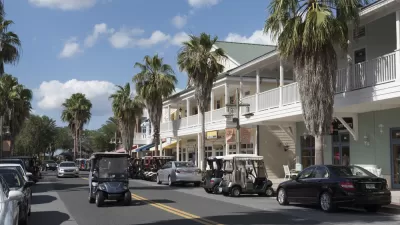The exurban town of Buckeye, Arizona, is expected over the next two decades to grow from a population of 25,000 to more than 400,000. Planners are trying to do what they can to control the flood.
"Whereas Interstate 10 once threatened to suck the life out of Buckeye, it has recently proved to be one of the keys to the town's incredible reawakening-as a beeline toward more affordable housing beyond Phoenix's outer ring. Earlier this decade, developers began laying claim to huge pieces of land around Buckeye for new subdivisions and shopping centers. Across much of the Phoenix area, this influx has already brought miles of neighborhoods where houses sit rather far from shops, services, or anything fun, so it's hard to walk from here to there."
"Buckeye-given the fast pace of its development-might be the last place you would expect to find anything smarter. But the town's planners and politicians are trying to get ahead of the vacuum that a developer's nature abhors, and design, of all things, a sustainable suburb. Over the past few years, they have been seriously overworked."
"Over the past several years, the town of Buckeye has annexed 370 square miles of this land into its corporate limits, and its total planning area, which it intends to annex eventually, measures 598 square miles, which is larger than Phoenix. From its northernmost corporate limit to its southernmost, Buckeye runs about 45 miles long. From east to west, it is 24 miles wide."
"Right now, across much of this terrain, it doesn't look as if much is going on, particularly along the Sun Valley Parkway, a four-lane divided road that stretches north from Interstate 10 into the desert before turning east back to Surprise. It has been called the Road to Nowhere. Off the interstate, a sign on the parkway cautions that there are no services for the next 35 miles."
"'You're still driving through the heart of Buckeye,' said Phil Marcotte, the chief building official for the town, who was doing the actual driving. Marcotte, who started work for the town in 1994, when it had about 5,600 people, offered to show me around the vast tracts of Buckeye where developers are laying seed for 22 approved master planned communities that are expected, by 2030, to hold more than 400,000 people."
FULL STORY: Buckeye, Next 6 Exits

Maui's Vacation Rental Debate Turns Ugly
Verbal attacks, misinformation campaigns and fistfights plague a high-stakes debate to convert thousands of vacation rentals into long-term housing.

Planetizen Federal Action Tracker
A weekly monitor of how Trump’s orders and actions are impacting planners and planning in America.

San Francisco Suspends Traffic Calming Amidst Record Deaths
Citing “a challenging fiscal landscape,” the city will cease the program on the heels of 42 traffic deaths, including 24 pedestrians.

Defunct Pittsburgh Power Plant to Become Residential Tower
A decommissioned steam heat plant will be redeveloped into almost 100 affordable housing units.

Trump Prompts Restructuring of Transportation Research Board in “Unprecedented Overreach”
The TRB has eliminated more than half of its committees including those focused on climate, equity, and cities.

Amtrak Rolls Out New Orleans to Alabama “Mardi Gras” Train
The new service will operate morning and evening departures between Mobile and New Orleans.
Urban Design for Planners 1: Software Tools
This six-course series explores essential urban design concepts using open source software and equips planners with the tools they need to participate fully in the urban design process.
Planning for Universal Design
Learn the tools for implementing Universal Design in planning regulations.
Heyer Gruel & Associates PA
JM Goldson LLC
Custer County Colorado
City of Camden Redevelopment Agency
City of Astoria
Transportation Research & Education Center (TREC) at Portland State University
Jefferson Parish Government
Camden Redevelopment Agency
City of Claremont





























